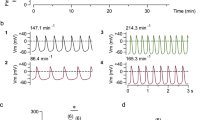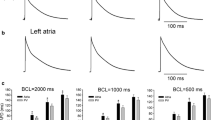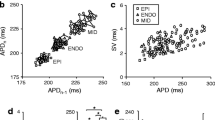Abstract
We studied the potassium current flowing through TREK-1 channels in rat cardiac ventricular myocytes. We separated the TREK-1 current from other current components by blocking most other channels with a blocker cocktail. We tried to inhibit the TREK-1 current by activating protein kinase A (PKA) with a mixture of forskolin and isobutyl-methylxanthine (IBMX). Activation of PKA blocked an outwardly rectifying current component at membrane potentials positive to −40 mV. At 37 °C, application of forskolin plus IBMX reduced the steady-state outward current measured at positive voltages by about 52 %. Application of the potassium channel blockers quinidine or tetrahexylammonium also reduced the steady-state outward current by about 50 %. Taken together, our results suggest that the increase in temperature from 22 to 37 °C increased the TREK-1 current by a factor of at least 5 and that the average density of the TREK-1 current in rat cardiomyocytes at 37 °C is about 1.5 pA/pF at +30 mV. The contribution of TREK-1 to the action potential was assessed by using a dynamic patch clamp technique. After subtraction of simulated TREK-1 currents, action potential duration at 50 or 90 % repolarisation was increased by about 12 %, indicating that TREK-1 may be functionally important in rat ventricular muscle. During sympathetic stimulation, inhibition of TREK-1 channels via PKA is expected to prolong the action potential primarily in subendocardial myocytes; this may decrease the transmural dispersion of repolarisation and thus may serve to prevent the occurrence of arrhythmias.





Similar content being viewed by others
References
Antzelevitch C (2007) Role of spatial dispersion of repolarization in inherited and acquired sudden cardiac death syndromes. Am J Physiol Heart Circ Physiol 293:H2024–H2038
Bond RC, Choisy SC, Bryant SM, Hancox JC, James AF (2014) Inhibition of a TREK-like K+ channel current by noradrenaline requires both beta1- and beta2-adrenoceptors in rat atrial myocytes. Cardiovasc Res 104:206–215
Carmeliet E (2006) Action potential duration, rate of stimulation, and intracellular sodium. J Cardiovasc Electrophysiol 17(Suppl 1):S2–S7
Casis O, Iriarte M, Gallego M, Sanchez-Chapula JA (1998) Differences in regional distribution of K+ current densities in rat ventricle. Life Sci 63:391–400
Chandrasekera PC, Wan TC, Gizewski ET, Auchampach JA, Lasley RD (2013) Adenosine A1 receptors heterodimerize with beta1- and beta2-adrenergic receptors creating novel receptor complexes with altered G protein coupling and signaling. Cell Signal 25:736–742
Conrath CE, Opthof T (2006) Ventricular repolarization: an overview of (patho)physiology, sympathetic effects and genetic aspects. Prog Biophys Mol Biol 92:269–307
Daut J, Rüdel R (1982) The electrogenic sodium pump in guinea-pig ventricular muscle: inhibition of pump current by cardiac glycosides. J Physiol 330:243–264
Dixon JE, Shi W, Wang HS, McDonald C, Yu H, Wymore RS, Cohen IS, McKinnon D (1996) Role of the Kv4.3 K+ channel in ventricular muscle. A molecular correlate for the transient outward current. Circ Res 79:659–668
Enyeart JA, Danthi SJ, Enyeart JJ (2004) TREK-1 K+ channels couple angiotensin II receptors to membrane depolarization and aldosterone secretion in bovine adrenal glomerulosa cells. Am J Physiol Endocrinol Metab 287:E1154–E1165
Fink M, Duprat F, Lesage F, Reyes R, Romey G, Heurteaux C, Lazdunski M (1996) Cloning, functional expression and brain localization of a novel unconventional outward rectifier K+ channel. EMBO J 15:6854–6862
Franz MR, Cima R, Wang D, Profitt D, Kurz R (1992) Electrophysiological effects of myocardial stretch and mechanical determinants of stretch-activated arrhythmias. Circulation 86:968–978
Hartzell HC, Fischmeister R (1986) Opposite effects of cyclic GMP and cyclic AMP on Ca2+ current in single heart cells. Nature 323:273–275
Heurteaux C, Lucas G, Guy N, El Yacoubi M, Thummler S, Peng XD, Noble F, Blondeau N, Widmann C, Borsotto M, Gobbi G, Vaugeois JM, Debonnel G, Lazdunski M (2006) Deletion of the background potassium channel TREK-1 results in a depression-resistant phenotype. Nat Neurosci 9:1134–1141
Honore E (2007) The neuronal background K2P channels: focus on TREK1. Nat Rev Neurosci 8:251–261
Hund TJ, Snyder JS, Wu X, Glynn P, Koval OM, Onal B, Leymaster ND, Unudurthi SD, Curran J, Camardo C, Wright PJ, Binkley PF, Anderson ME, Mohler PJ (2014) beta(IV)-Spectrin regulates TREK-1 membrane targeting in the heart. Cardiovasc Res 102:166–175
Jespersen T, Grunnet M, Olesen SP (2005) The KCNQ1 potassium channel: from gene to physiological function. Physiology (Bethesda) 20:408–416
Kang D, Choe C, Kim D (2005) Thermosensitivity of the two-pore domain K+ channels TREK-2 and TRAAK. J Physiol 564:103–116
Kelly D, Mackenzie L, Hunter P, Smaill B, Saint DA (2006) Gene expression of stretch-activated channels and mechanoelectric feedback in the heart. Clin Exp Pharmacol Physiol 33:642–648
Kim D (1992) A mechanosensitive K+ channel in heart cells. Activation by arachidonic acid. J Gen Physiol 100:1021–1040
Kim D, Clapham DE (1989) Potassium channels in cardiac cells activated by arachidonic acid and phospholipids. Science 244:1174–1176
Laursen M, Olesen SP, Grunnet M, Mow T, Jespersen T (2011) Characterization of cardiac repolarization in the Göttingen minipig. J Pharmacol Toxicol Methods 63:186–195
Leroy J, Abi-Gerges A, Nikolaev VO, Richter W, Lechene P, Mazet JL, Conti M, Fischmeister R, Vandecasteele G (2008) Spatiotemporal dynamics of beta-adrenergic cAMP signals and L-type Ca2+ channel regulation in adult rat ventricular myocytes: role of phosphodiesterases. Circ Res 102:1091–1100
Li GR, Feng J, Yue L, Carrier M (1998) Transmural heterogeneity of action potentials and Ito1 in myocytes isolated from the human right ventricle. Am J Physiol 275:H369–H377
Li XT, Dyachenko V, Zuzarte M, Putzke C, Preisig-Müller R, Isenberg G, Daut J (2006) The stretch-activated potassium channel TREK-1 in rat cardiac ventricular muscle. Cardiovasc Res 69:86–97
Limberg SH, Netter MF, Rolfes C, Rinné S, Schlichthörl G, Zuzarte M, Vassiliou T, Moosdorf R, Wulf H, Daut J, Sachse FB, Decher N (2011) TASK-1 channels may modulate action potential duration of human atrial cardiomyocytes. Cell Physiol Biochem 28:613–624
Lin E, Ribeiro A, Ding W, Hove-Madsen L, Sarunic MV, Beg MF, Tibbits GF (2014) Optical mapping of the electrical activity of isolated adult zebrafish hearts: acute effects of temperature. Am J Physiol Regul Integr Comp Physiol 306:R823–R836
Lotshaw DP (2007) Biophysical, pharmacological, and functional characteristics of cloned and native mammalian two-pore domain K+ channels. Cell Biochem Biophys 47:209–256
Maingret F, Lauritzen I, Patel AJ, Heurteaux C, Reyes R, Lesage F, Lazdunski M, Honore E (2000) TREK-1 is a heat-activated background K+ channel. EMBO J 19:2483–2491
Meadows HJ, Benham CD, Cairns W, Gloger I, Jennings C, Medhurst AD, Murdock P, Chapman CG (2000) Cloning, localisation and functional expression of the human orthologue of the TREK-1 potassium channel. Pflugers Arch 439:714–722
Murbartian J, Lei Q, Sando JJ, Bayliss DA (2005) Sequential phosphorylation mediates receptor- and kinase-induced inhibition of TREK-1 background potassium channels. J Biol Chem 280:30175–30184
Näbauer M, Beuckelmann DJ, Überfuhr P, Steinbeck G (1996) Regional differences in current density and rate-dependent properties of the transient outward current in subepicardial and subendocardial myocytes of human left ventricle. Circulation 93:168–177
Nerbonne JM, Kass RS (2005) Molecular physiology of cardiac repolarization. Physiol Rev 85:1205–1253
Overholser BR, Zheng X, Tisdale JE (2008) Catecholaminergic effects on ventricular repolarization during inhibition of the rapid component of the delayed rectifier potassium current in a perfused heart model. Pharmacotherapy 28:1315–1324
Patel AJ, Honore E, Maingret F, Lesage F, Fink M, Duprat F, Lazdunski M (1998) A mammalian two pore domain mechano-gated S-like K+ channel. EMBO J 17:4283–4290
Patel C, Yan GX, Antzelevitch C (2010) Short QT syndrome: from bench to bedside. Circ Arrhythm Electrophysiol 3:401–408
Piechotta PL, Rapedius M, Stansfeld PJ, Bollepalli MK, Ehrlich G, Andres-Enguix I, Fritzenschaft H, Decher N, Sansom MS, Tucker SJ, Baukrowitz T (2011) The pore structure and gating mechanism of K2P channels. EMBO J 30:3607–3619
Putzke C, Wemhöner K, Sachse FB, Rinné S, Schlichthörl G, Li XT, Jae L, Eckhardt I, Wischmeyer E, Wulf H, Preisig-Müller R, Daut J, Decher N (2007) The acid-sensitive potassium channel TASK-1 in rat cardiac muscle. Cardiovasc Res 75:59–68
Quadbeck J, Reiter M (1975) Adrenoceptors in cardiac ventricular muscle and changes in duration of action potential caused by noradrenaline and isoprenaline. Naunyn Schmiedeberg's Arch Pharmacol 288:403–414
Ravens U (2003) Mechano-electric feedback and arrhythmias. Prog Biophys Mol Biol 82:255–266
Rinné S, Renigunta V, Schlichthörl G, Zuzarte M, Bittner S, Meuth SG, Decher N, Daut J, Preisig-Müller R (2014) A splice variant of the two-pore domain potassium channel TREK-1 with only one pore domain reduces the surface expression of full-length TREK-1 channels. Pflugers Arch 466:1559–1570
Ruzsnavszky F, Hegyi B, Kistamas K, Vaczi K, Horvath B, Szentandrassy N, Banyasz T, Nanasi PP, Magyar J (2014) Asynchronous activation of calcium and potassium currents by isoproterenol in canine ventricular myocytes. Naunyn Schmiedeberg's Arch Pharmacol 387:457–467
Sanguinetti MC, Jurkiewicz NK, Scott A, Siegl PK (1991) Isoproterenol antagonizes prolongation of refractory period by the class III antiarrhythmic agent E-4031 in guinea pig myocytes. Mechanism of action. Circ Res 68:77–84
Scamps F (1996) Characterization of a beta-adrenergically inhibited K+ current in rat cardiac ventricular cells. J Physiol 491(Pt 1):81–97
Schiekel J, Lindner M, Hetzel A, Wemhöner K, Renigunta V, Schlichthörl G, Decher N, Oliver D, Daut J (2013) The inhibition of the potassium channel TASK-1 in rat cardiac muscle by endothelin-1 is mediated by phospholipase C. Cardiovasc Res 97:97–105
Schmitt N, Grunnet M, Olesen SP (2014) Cardiac potassium channel subtypes: new roles in repolarization and arrhythmia. Physiol Rev 94:609–653
Sharp AA, O'Neil MB, Abbott LF, Marder E (1993) The dynamic clamp: artificial conductances in biological neurons. Trends Neurosci 16:389–394
Shimizu W, Horie M (2011) Phenotypic manifestations of mutations in genes encoding subunits of cardiac potassium channels. Circ Res 109:97–109
Shimizu W, Noda T, Takaki H, Kurita T, Nagaya N, Satomi K, Suyama K, Aihara N, Kamakura S, Sunagawa K, Echigo S, Nakamura K, Ohe T, Towbin JA, Napolitano C, Priori SG (2003) Epinephrine unmasks latent mutation carriers with LQT1 form of congenital long-QT syndrome. J Am Coll Cardiol 41:633–642
Shimizu W, Noda T, Takaki H, Nagaya N, Satomi K, Kurita T, Suyama K, Aihara N, Sunagawa K, Echigo S, Miyamoto Y, Yoshimasa Y, Nakamura K, Ohe T, Towbin JA, Priori SG, Kamakura S (2004) Diagnostic value of epinephrine test for genotyping LQT1, LQT2, and LQT3 forms of congenital long QT syndrome. Heart Rhythm 1:276–283
Shutt RH, Howlett SE (2008) Hypothermia increases the gain of excitation-contraction coupling in guinea pig ventricular myocytes. Am J Physiol Cell Physiol 295:C692–C700
Szentandrassy N, Kistamas K, Hegyi B, Horvath B, Ruzsnavszky F, Vaczi K, Magyar J, Banyasz T, Varro A, Nanasi PP (2014) Contribution of ion currents to beat-to-beat variability of action potential duration in canine ventricular myocytes. Pflugers Arch. doi:10.1007/s00424-014-1581-4
Tan JH, Liu W, Saint DA (2004) Differential expression of the mechanosensitive potassium channel TREK-1 in epicardial and endocardial myocytes in rat ventricle. Exp Physiol 89:237–242
Tatewaki T, Inagaki M, Kawada T, Shishido T, Yanagiya Y, Takaki H, Sato T, Sugimachi M, Sunagawa K (2003) Biphasic response of action potential duration to sudden sympathetic stimulation in anesthetized cats. Circ J 67:876–880
ter Bekke RM, Volders PG (2012) Arrhythmogenic mechano-electric heterogeneity in the long-QT syndrome. Prog Biophys Mol Biol 110:347–358
Terrenoire C, Clancy CE, Cormier JW, Sampson KJ, Kass RS (2005) Autonomic control of cardiac action potentials: role of potassium channel kinetics in response to sympathetic stimulation. Circ Res 96:e25–e34
Terrenoire C, Lauritzen I, Lesage F, Romey G, Lazdunski M (2001) A TREK-1-like potassium channel in atrial cells inhibited by beta-adrenergic stimulation and activated by volatile anesthetics. Circ Res 89:336–342
Trautwein W (1973) Membrane currents in cardiac muscle fibers. Physiol Rev 53:793–835
Trautwein W, Dudel J (1954) Action potential and mechanogram of cat's papillary muscle as a function of temperature. Pflugers Arch 260:104–115
Tristani-Firouzi M (2014) the long and short of it: insights into the short QT syndrome. J Am Coll Cardiol 63:1309–1310
Veldkamp MW, Verkerk AO, van Ginneken AC, Baartscheer A, Schumacher C, de Jonge N, de Bakker JM, Opthof T (2001) Norepinephrine induces action potential prolongation and early afterdepolarizations in ventricular myocytes isolated from human end-stage failing hearts. Eur Heart J 22:955–963
Volders PG (2010) Novel insights into the role of the sympathetic nervous system in cardiac arrhythmogenesis. Heart Rhythm 7:1900–1906
Volders PG, Stengl M, van Opstal JM, Gerlach U, Spatjens RL, Beekman JD, Sipido KR, Vos MA (2003) Probing the contribution of IKs to canine ventricular repolarization: key role for beta-adrenergic receptor stimulation. Circulation 107:2753–2760
Vyas H, Hejlik J, Ackerman MJ (2006) Epinephrine QT stress testing in the evaluation of congenital long-QT syndrome: diagnostic accuracy of the paradoxical QT response. Circulation 113:1385–1392
Walsh KB, Begenisich TB, Kass RS (1988) Beta-adrenergic modulation in the heart. Independent regulation of K and Ca channels. Pflugers Arch 411:232–234
Walsh KB, Kass RS (1988) Regulation of a heart potassium channel by protein kinase A and C. Science 242:67–69
Wilders R (2006) Dynamic clamp: a powerful tool in cardiac electrophysiology. J Physiol 576:349–359
Zabel M, Koller BS, Sachs F, Franz MR (1996) Stretch-induced voltage changes in the isolated beating heart: importance of the timing of stretch and implications for stretch-activated ion channels. Cardiovasc Res 32:120–130
Zhao LN, Fu L, Gao QP, Xie RS, Cao JX (2011) Regional differential expression of TREK-1 at left ventricle in myocardial infarction. Can J Cardiol 27:826–833
Acknowledgments
We thank Brigitte Burk for excellent technical support. This study was supported by the Deutsche Forschungsgemeinschaft (FOR 1086, TP7).
Author information
Authors and Affiliations
Corresponding author
Additional information
This article is published as part of the special issue on K2P channels.
Rights and permissions
About this article
Cite this article
Bodnár, M., Schlichthörl, G. & Daut, J. The potassium current carried by TREK-1 channels in rat cardiac ventricular muscle. Pflugers Arch - Eur J Physiol 467, 1069–1079 (2015). https://doi.org/10.1007/s00424-014-1678-9
Received:
Revised:
Accepted:
Published:
Issue Date:
DOI: https://doi.org/10.1007/s00424-014-1678-9




